Bearing the brunt: Unnoticed conflict quietly shatters lives
Escalating violence nationwide striking fear, hopelessness in citizens.
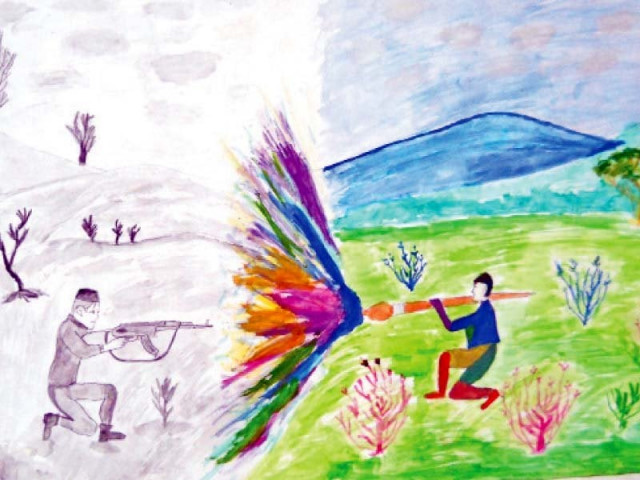
A child’s painting from Swat seeking an end to violence. PHOTO: IRIN
In a classroom in a private school in Islamabad, a group of fifth graders doing their history lessons are adamant when asked a question about conflict.
“Pakistan has fought three wars — in 1948, in 1965 and in 1971, all against India,” said Muhammad Asif, 10, standing sternly to attention as he responds. Like his classmates, he looks puzzled when asked if the country could still be engaged in a war.
But the figures for deaths as a result of conflict across the country say something quite different: according to the New Delhi-based South Asia Terrorism Portal, which monitors militancy in the region, 5,379 people lost their lives in terrorist-related incidents in 2013. The majority — 3,001 — were civilians.
The number has escalated sharply since 2005, and reached a peak in 2009, when 11,704 people were killed — mainly during a military operation against militants in the Swat Valley in Khyber-Pakhtunkhwa Province. The violence continues to be widespread — even considered normal — with 460 already killed this year.
“For people like us, the ongoing violence, the terrorist attacks and then the military reprisals are a disaster,” said Saifullah Khan, a resident of Wana, South Waziristan. “We live in constant fear, people have lost jobs because businesses have shut down, and so many people I know have moved away permanently.
“Of course there is a war here. People die in bomb attacks, families have been destroyed and children know only of guns,” he told IRIN. He also spoke of farmers whose lands had been destroyed, leaving them with no means to earn a living.
While the conflict against the Taliban is possibly the best known issue involving violence in Pakistan, there are many other pieces making up a larger and more complex picture.
“Endemic” violence
According to a 2014 report by the Washington-based US Institute of Peace Studies, “during the past decade violence has become endemic across many parts of Pakistan.”
The detailed study notes the “origins and intensity” of violence varies by region. Other than the concentrated violence along the Afghan border driven by militancy, it describes growing sectarian violence in Gilgit-Baltistan and Balochistan, caused partially as a result of a “nexus between sectarian militants and terrorist outfits”.
“We see a continued escalation in this violence, and the impact on people’s lives is very negative. They lose security, opportunity, sometimes education and we live with almost constant fear.”
It also states there has been a 10-fold increase in violence in Karachi between 2006 and 2013, with sectarian groups, terrorist outfits, political parties and criminal gangs all playing a role.
In Balochistan the “scale, scope and magnitude” of violence is stated to be “unprecedented”, involving sectarian and terrorist violence combined with a secessionist insurgency which has, since 2006, led to a conflict with the Pakistan military. While the Punjab has experienced the least violence, it has turned into a key ground for recruiting militants.
Figures from the Islamabad-based Centre for Research and Security Studies’ (CRSS) Pakistan Conflict Tracker, which differ slightly from the South Asia Terrorism Portal, suggest 2013 was one of the deadliest on record, with nearly 6,000 people killed in militant, sectarian, terrorist and politically-motivated attacks.
“Constant fear”
“We see a continued escalation in this violence, and the impact on people’s lives is very negative. They lose security, opportunity, sometimes education and we live with almost constant fear. People are afraid to travel or even visit parks and other public places,” Fariha Nazir, a research fellow at CRSS, told IRIN.
Asghar Jalil, a banker in Quetta, said, “Of course we are affected; our lives have changed. My family moved here when I was an infant, it is my home. But now because of the threat to Punjabi settlers from Baloch nationalists, I hardly ever allow my three children to leave the house, except for school. We are fearful till their return.”
There have been a number of attacks on persons from other provinces living in Balochistan.
Others have been left in a particularly grim situation. “My husband died in a random shooting in 2010. My children are young, I can find no work, and though my brother-in-law helps sometimes we barely have enough to eat,” Jalila Bibi* told IRIN from Karachi. Two of her children no longer attend school because she cannot pay the fees. *Name changed to protect identity
Published in The Express Tribune, February 20th, 2014.

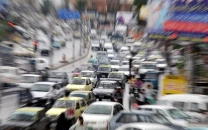
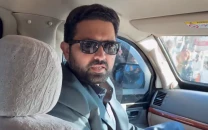
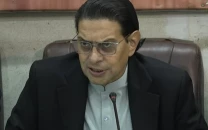

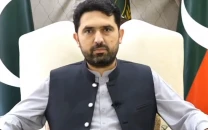













COMMENTS
Comments are moderated and generally will be posted if they are on-topic and not abusive.
For more information, please see our Comments FAQ